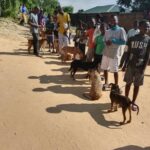GET TO KNOW THE REASONS WHY KISSING IS BETTER THAN SMOKING
Published on July 30, 2015 at 7:47 AM by Robert Ngwira
Kissing has overtaken smoking and drinking as the leading risk factor for developing head and neck cancers.
The humble French kiss can pass on human papilloma virus (HPV), and Head of Maxillofacial and Head and neck Surgery at the Royal Darwin Hospital, Dr Mahiban Thomas, said the virus was responsible for 70% of head and neck cancer cases.
Dr Thomas told Daily Mail Australia if you became infected by HPV in the oropharynx, your risk of developing head and neck cancer was 250 times higher than that of someone without the virus.
While most commonly associated with cervical cancers, HPV can affect both men and women.
There are more than 100 types of the virus, but only about eight ‘high risk’ strains of HPV that can cause cancers in the oropharynx.
The Centers for Disease Control and Prevention said studies suggest Oral HPV could be passed on during oral sex or open-mouthed or ‘French’ kissing, and about 7% of people have oral HPV, but only 1% of people have the type of oral HPV that is found in oropharyngeal cancers.
Dr Thomas said recent studies suggested even engaging in ‘petting’ without sexual interaction could transfer HPV.
‘If you look at the figures coming out of the US, 70 per cent of head and neck cancers are due to HPV,’ Dr Thomas said.
‘There has been a change in high-risk behaviour as far as smoking and drinking goes.
‘If you have an (HPV) infection, you have 250 times the chance of developing cancer of somebody who does not have HPV.’
Dr Thomas told NT News HPV was responsible for a ‘tsunami’ of head and neck cancer cases.
He said your risk of contracting the HPV virus increased with the number of French kissing partners you had, and people underrated the risks associated with oral sex.
Yesterday marked World Head and Neck Cancer Day.
In 2011, 3121 head and neck cancers were diagnosed in Australia, caused by smoking, frequent alcohol use, sun exposure, radiation, asbestos and HPV.
The Australian Government funds HPV vaccination for 12 to 13-year-old girls and boys which helps protect against cervical cancer, some vaginal, vulva and anal cancers and genital warts.


